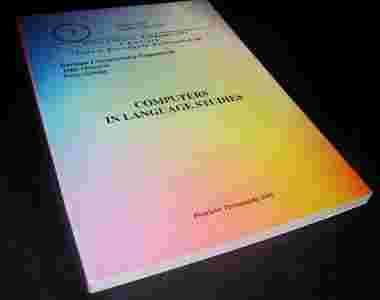|
Table of contents
Introduction
CHAPTER ONE:
INFORMATION AND COMMUNICATION TECHNOLOGY
(ICT) AND MAJOR TRENDS IN WESTERN EUROPEAN
SOCIETIES (Frits Schulte).
1.1. Introduction .
1.2. Trends in Western/European societies .
1.2.1. The technological society
1.2.2. The information society.
1.2.3. The communication society .
1.2.4. The media society
1.3. Conclusion
CHAPTER TWO:
ICT AND DIGITALLY ENRICHED LEARNING ENVIRONMENTS
(Frits Schulte) 27
2.1. Introduction. 27
2.2. Autonomous, lifelong learning and the digitally
enriched learning environment. 28
2.2.1. The new educational paradigm. 28
2.2.2. The digitally enriched learning environment 30
2.2.3. Examples of digital learning environments: Webquests and
LeamingSpace 30
2.3. Basic conditions for the creation of digitally enriched
learning environments. 33
2.3.1. ICT as part of a systemic approach to lifelong learning. 33
2 3.2. The three "e's". 34
2.3.3. The integrative revolutionary approach 34
2.3.4. Embedding ICT in the entire school organisation35
2.3.5. ICT-applications in education. 37
2.4. The integrative, revolutionary approach in action.
2.4.1. The Dutch study house.
2.4.2. The Dutch/European educational
computer driving licence.
2.4.3. ICT-entitlement and language learning
2.5. Conclusion
CHAPTER THREE;
COMPUTERS AND THE FOREIGN LANGUAGE
TEACHER AND LEARNER (John Osbome).
3. 1. Introduction.
3. 2. What are the advantages of using computers? Research
and practice in ICT for language learning.
3.3. Varieties of CALL.
3. 4. Language learning and CALL software.
3. 4.1. Introduction.
3. 4.2. Capabilities and limitations of call software.
3. 4.3. Developing language knowledge: Phonetics
3. 4.4. Lexis.
3. 4.5. Grammar.
3. 4.5. Developing language skills: speaking.
3. 4.6. Writing.
3. 4.7. Listening.
3. 4.8. Reading
3. 5. Do it yourself: teachers and materials production.
3. 5.1. Do it yourself authoring.
3. 5.2. Web-authoring
3. 5.3. Template packages.
3. 5.5. Multimedia authoring systems.
3. 6. Conclusion
CHAPTER FOUR:
COMPUTERS, LANGUAGE CORPORA AND THEIR
APPLICATIONS (Barbara Lewandowska-Tomaszczyk)
4. 1. Computational Linguistics and Corpus Linguistics.
4. 2. Definition and typology of corpora
4.2. 1. The PELCRA project
4. 3. Corpora and the definition of language
4. 3. 1. The place of corpora in language study.
4. 3. 2. Corpus adequacy
4. 4. Positive and negative evidence in corpus material
4. 5. Corpus analysis tools -concordances
4. 6. Annotated corpora - tagging
4. 6. 1. Word-forms and lemmas
4. 7. Models in natural language processing (NLP).
4. 7. 1. Cognitive models in NLP.
4. 7. 2. Statistical methods in parsing
4, 7. 3. Advantages of electronic linguistic access and retrieval.
4. 8. Computerised lexical knowledge.
4. 8. 1. Lexical acquisition.
4. 8. 2. Bilingual alignment of the Plato text.
4. 8. 3. Reusability of lexical resources.
4. 9. Corpus-based linguistic analysis .
4. 9. 1. Linguistic analysis in Corpus Linguistics
4. 9. 2. Association patterns.
4.10. Learning about language from authentic language data
4. 10. 1. Meaning .
4. 10. 2. Lexis and lexical combinations
4. 10. 3. Feature extraction, feature defeating and emphasis.
4. 10. 4. Semantic prosody
4. 10. 5. The contribution of syntax to semantic prosodies
4. 10. 6. Antonymous polysemy
4. 10. 6. 1. The case of handicap
4. 10. 7. Conceptual clusters and ideology in language corpora.
4. 11. Cross-linguistic corpus analysis
4. 11. 1. One language, more languages
4. 11.2. Corpus grammars
4. 11.3. Corpora and some Polish - English syntactic contrasts
4. 11. 4. The case of dance verbs - a contrastive asymmetry
4. 11.5. Contrastive Polish-English syntactic variation
- permit /allow /admit.
4. 11. 6. The case of synonymy - sick and ill
4.12. Language corpora - a tool in foreign language teaching
4. 12. 1. The role of computers in FL pedagogy.
4. 12. 2. Corpus data in FLT.
4. 12. 3. Concordances as a FLT tool.
4. 12. 4. The role of the teacher
4. 12. 5. Learner Corpora - a tool in FL teaching .
4. 13. Corpora and the dictionary
4. 13. 1. Linguistic reference tools
4. 13. 2. The Bilingual Dictionary/Thesaurus [BITj.
4. 13. 3. Uncovering lexical senses and syntax.
4. 13. 4. Glossaries
4. 14. Computers in translation
4. 14. 1. Machine Translation (MT) and Computer-Assisted
Translation (CAT).
4. 14. 2. Corpora and the translation trainee.
4. 14. 3. CAT dictionaries and termbanks.
4. 14. 4. What do computerised electronic
tools offer the translator?,
4. 14. 5. Prospective corpus developments
for translation/interpreting.
4.15. Corpus methodology - a tool in linguistic
and applied language tasks
4. 16. Future prospects .
REFERENCES
INTERNET ADDRESSES
GLOSSARY.
|

